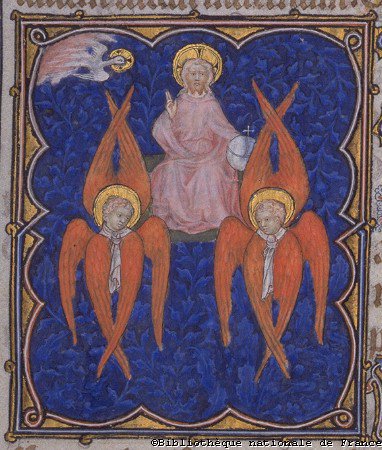‘Tis the season of Angels. They can be spotted midflight on Christmas cards, wrapping paper, and tree ornaments. In the marketplace, though, angels broke out of Christmas mode some time ago. Images of angels adorn almost anything these days, from jewelry and mugs to wallets and wallpaper.
It is fair to say that the Renaissance image of the roly-poly cherub-angel predominates in the popular imagination. For the grandest examples of such cherubs, you need look no farther than Raphael’s famous Sistine Madonna (1512). The pair of cherubs at Mary’s feet have eclipsed Mary’s image, as witnessed in the multitude of objects bearing their dubious faces found in the gift shops of the Zwinger in Dresden (where the painting is housed) and in countless gift shops around the world.
Such cherubic angels, though, have little to do with the staid, glorious Archangel Gabriel who appears several places in the Old Testament and came before a trembling girl named Mary with an announcement that changed the world (the Annunciation). Nor do these cherubs resemble the warlike Archangel Michael, whose references are spread far and wide, including in the Quran.

But within angels, we have the Seraphim who are characterized as “six-winged” and understood to be the highest rank of angels, standing at the top of the nine ranks of angels above even the Cherubim. (Yes, there is hierarchy in angelology, although like everything theological, it is surrounded by debate.) To use words found in the New Shorter Oxford Dictionary of English (1993), Seraphim are “gifted with love and associated with light, ardour, and purity.” The adjective derived from Seraphim, seraphic, indicates “beauty, purity, serene bliss, or fervent devotion.”
As with so much Christian imagery, the form and visage of the Seraphim come from ancient Judaism where, in Hebrew, the word saraph means “to burn” (שָׂרַף). The Old Testament presence of angelic Seraphim is encapsulated in the sixth chapter of the Book of Isaiah, which speaks of the six-winged “fiery” angels who ring the throne of God in constant worship.” Seraphim serve as agents of purification and come to Isaiah at the beginning of his ministry. Isaiah describes them as having human features like hands, feet, and faces.
The Seraphim also embody the ancient Jewish concept of “three-ness.” Both through having three pairs of wings, and by proclaiming Holy, Holy, Holy, they proclaim the concept of “three” which also characterizes Christianity, including the proclamation that “Christ is born, Christ has died, Christ will come again” and, of course, the Trinity of Father, Son, and Holy Ghost.
We find Seraphim marvelously and dramatically depicted both in paintings and iconography. It is easy to find material to inspire artists, particularly when we have references like Isaiah 6:4 where the angels’ voices assert God’s magnificence: “The doorposts and thresholds shook and the temple was filled with smoke.” We see the seraph picking up a burning coal “with tongs from the altar,” bringing the live coal to Isaiah, and touching it to his lips. This act purified Isaiah’s sins by fire, as the seraph assured Isaiah that now his “guilt is taken away and [his] sin atoned for.” Isaiah 6: 6-7
And those wonderful six wings! We moderns are so removed from interpreting ancient symbols that this feature of the Seraphim might seem a bit kitschy at first. But wings, wingedness, and the movement of wings has been important across time. This is something we grasp better when we remember that we humans have only recently been able to replicate flight, something our ancient forefathers endlessly pondered and aspired towards.
Each pair of the Seraphim’s wings has a different purpose and meaning. Two of the six wings conceal the angel’s face; two cover the feet; and the remaining two fly. The four wings used to cover serve to express humility before God. Recall as well as the verse from Exodus 33:20 that “no man may look upon God and live.” The covering of their angelic feet provides another symbol for hiding any unclean feature before the Lord. And the wings that fly? Well, two wings would be needed for proper flight, yes? Those two wings also are appointed to wait upon (serve) and venerate God.
To my surprise (but not really, upon second thought), riding the current wave of hyper-violent, mega-heroes dwarfing traditional heroes like Superman and Batman, a Seraph-like character from mythology has emerged in popular culture in the “Blood of Zeus” series (once again, classical mythology proves its staying power!). Rest assured, this antagonist has no connection with the angelic Seraphim, but do not be surprised if he shows up as you seek artistic, literary, or musical references for the biblical Seraphim.
It will not surprise you, either, to find important figures in Church history named after the Seraphim. The Russian monastic and wonderworker Seraphim of Sarov (1759-1833, born in Kursk as Prokhor Moshnin) is arguably the most prominent of all Russian saints—an historical figure who still exerts influence on Russian culture. If you’ve never read a hagiography (saint’s life), his story would be a fine one to begin with.
There is far more to consider theologically and liturgically regarding Seraphim. But for now, we are drawing closer to the cherished hush that falls on Christmas Eve. If you happen to live where you can see stars blazing in a truly dark sky, or if your starlight comes from a swirl of LED lights, let tonight be an opportunity to consider the ancient story of angels, their brilliance, their swords and swift judgments, their humility and invisible guidance.



